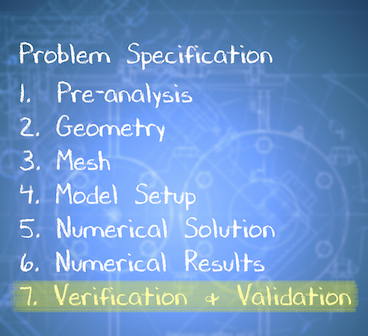...
...
...
| 2D Steady Conduction - Panel |
|---|
|
...
| 2D Steady Conduction - Panel |
|---|
|
Verification & Validation
Verification and validation can be thought of as a formal process for checking results. Each of these terms has a specific meaning which we won't get into here. The only verification check discussed below is investigation of the effect of mesh size on the results.
Refine Mesh
Let's check what happens to the heat flux variation along the bottom surface when we refine the mesh i.e. use more elements in the mesh. We double the number of divisions in x and y directions which yields four times (2x2) the number of elements in the refined mesh.
 Image Added
Image Added
Verification Overview
| HTML |
|---|
<iframe width="640" height="360" src="https://www.youtube.com/embed/9RKcXN6xkD4" frameborder="0" allowfullscreen></iframe> |
Check Your Understanding
Select true or false.
Verification involves comparison with experimental data.
(To see the answer, go to the 2D Conduction section of Module 1 in
| New window link |
|---|
| Link | https://courses.edx.org/courses/course-v1:CornellX+ENGR2000X+1T2017/course/ |
|---|
|
our free online course on ANSYS simulations. |
You need to sign in to edX.org to access the course.)Check Energy Conservation
| HTML |
|---|
<iframe width="640" height="360" src="https: |
| HTML |
|---|
<iframe width="600" height="338" src="//www.youtube.com/embed/F1_I9oMJ1XEDvWdFGyKvA4" frameborder="0" allowfullscreen></iframe> |
Check Numerical Error
| HTML |
|---|
<iframe <iframe width="600640" height="338360" src="https://www.youtube.com/embed/WGeYMRORW4ApyvOziL5mso" frameborder="0" allowfullscreen></iframe> |
We find that the heat flux variation along the bottom surface is almost the same on the two finer meshes (20x40 and 40x80). This demonstrates that the results on the two finest meshes are mesh independent and are likely very close to the exact solution which could be derived using separation of variables.
Go to Exercises
Go to all ANSYS Learning Modules
 Sign-up for free online course on ANSYS simulations!
Sign-up for free online course on ANSYS simulations!